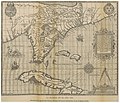Plaetje:1591 De Bry and Le Moyne Map of Florida and Cuba - Geographicus - Florida-debry-1591.jpg

Grootte van deze voorvertoning: 775 × 599 pixels. Andere resoluties: 310 × 240 pixels | 621 × 480 pixels | 993 × 768 pixels | 1.280 × 990 pixels | 2.560 × 1.980 pixels | 4.500 × 3.480 pixels.
Volledige resolutie (4.500 × 3.480 pixels, bestandsgroôtte: 6,38 MB, MIME-type: image/jpeg)
Bestandsgeschiedenisse
Klik op 'n datum/tied om 't bestand te zien zoas 't van d'r tied woas.
| Datum/tied | Miniatuur | Ofmetiengen | Gebruker | Opmerkienge | |
|---|---|---|---|---|---|
| hudige versie | 22 mrt 2011 19:21 |  | 4.500 × 3.480 (6,38 MB) | BotMultichillT | {{subst:User:Multichill/Geographicus |link=http://www.geographicus.com/P/AntiqueMap/Florida-debry-1591 |product_name=1591 De Bry and Le Moyne Map of Florida and Cuba |map_title=Floridae Americae Provinciae Recens & Exactissima Descriptio Auctore Iacobo Le |
Bestandsgebruuk
Dit bestand òdt op de volgende pagina gebruukt:
Globaal bestandsgebruik
De volgende andere wiki's gebruiken dit bestand:
- Gebruikt op la.wikipedia.org
- Gebruikt op nl.wikipedia.org

